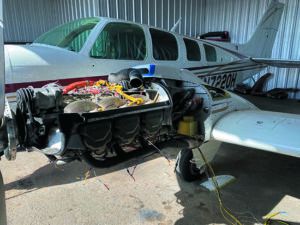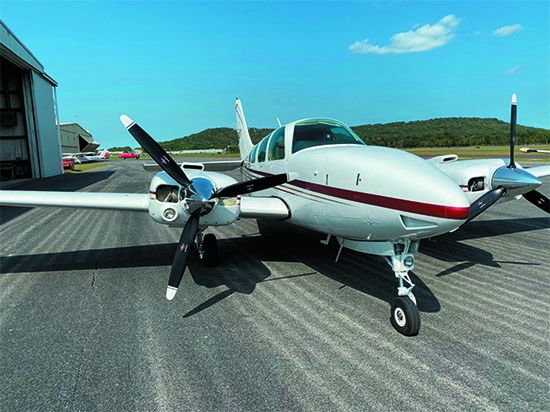When my wife and I bought our first plane, a beautiful polished V-tail Bonanza, we thought it would be the only plane we’d ever own. That was 20 years ago, and as our family grew, the demands on the plane began to outstrip its capabilities. The obvious step-up to something bigger was the A36 Bonanza—the last plane we said we would own. Over the next six years, the wee ones multiplied and grew, so we incrementally improved the plane to accommodate the increasing amount of stuff and weight.
But like the V-tail, with everyone carrying stuff in their lap for shortage of space, we realized we needed yet a bigger plane. This time, though, the decision wasn’t so cut and dry. Here is an anatomy of a single to twin step-up in hopes of helping others in a similar position.
CRUNCHING THE DATA
The Bonanza is a fantastic airplane by any measure. We had become spoiled by its solidity, stability, performance, steadfast reliability and comfort. Finding a suitable replacement, we thought, could prove to be a challenge. But, the wife and I are both data people, so out came the analysis tools and the beginning of an adventure that would last seven months.
The first step of the process was to define the mission, which everyone should carefully do before stepping up to any plane. In our case, it was fairly straightforward: The plane had to haul six people with enough room to keep baggage out of everyone’s laps, have comfort and endurance for three- to four-hour legs when fully loaded, it had to be at least as fast as the Bonanza and all of that had to be at a price we could afford.
Cabin-class singles were the initial subject of interest, but the six-seat requirement in itself left few choices. Still, we identified every potential option that fit the basic criterion. Performance, weight and balance, range and payload were studied. Reliability research was done. Maintenance and operating cost analyses were performed. Every [mission] salient aspect we could think of was examined.
In the end, we concluded that no single-engine aircraft met enough of the requirements to be worth pursuing. The compromises inherent with a cabin-class single were just too great for our needs. We didn’t consider twins at first simply because of the perception that we couldn’t afford one. The old adage of “double the engines, four times the cost” kept lingering in the back of our minds. With the realities of large singles revealed, though, we turned our attention to twins.
The same methodology used on the singles was applied to light twins. As the process unfolded, the choices were reduced to the Cessna T303 Crusader (a rare model) and the Beech 58 Baron, obviously a lot more common. Ultimately, we decided the Baron was the better option for us. From start to finish, the type selection process alone took nearly two months.
SHOP CAREFULLY
Once we decided on buying a Baron, the challenging task of finding the right one began. I searched every source I could find and dug up aircraft from around the world, including ones in the U.S., Europe, South Africa, Australia, South America and Canada. Dozens of inquiries were made, a seemingly endless torrent of photos and logbooks were scrutinized. Numerous promising planes were eliminated from consideration for a variety of reasons. Eventually, I learned of the plane we ultimately bought while calling about another one (that had been snagged the day before I called). The current used aircraft market is not easy to navigate.
I flew out to take a look and found our eventual Baron to be a gem, albeit with functional circa 1985 (the year it was built) avionics. More analysis ensued and we determined it ticked the most boxes of everything we had looked at to that point. While its price was considerably more than we had planned on spending, as a total package it looked like a nearly ideal plane. My examination suggested a very clean plane and the prebuy confirmed it. A month after first looking at it, we had a new plane!
Turns out it encompasses everything great about the Bonanza, yet it’s better. I find it easier to fly and easier to load; it’s more stable, is more comfortable and feels more solid. While reliability to date hasn’t been quite as good as the Bonanza’s, we’ve been able to exorcise the gremlins and have been steadily updating the panel. Now, with major upgrades nearly complete she is truly ready to fulfill her mission.
LIFE WITH A TWIN

As with anything else in the airplane world, there are pros and cons. It’s both a blessing and a curse, and there are some key differences compared to owning a single.
• Performance: Expect a significant performance improvement. Our Baron is 20 to 30 percent faster than the Bonanza. It’s nearly half again heavier, yet control feel is very similar. The step up in performance is akin to that of going from a trainer to a high-performance single. Everything happens sooner, so one must think further ahead of the plane. It also means getting behind it can have more dire consequences.
I use ForeFlight for flight planning and filing. All trips are planned at 185 knots true and 65 percent power. With the performance data I’ve plugged into the app I can file the computed ETE plus 10, and consistently be within five minutes of actual flight time, regardless of the en-route altitude. Weight and balance is much easier to manage thanks to the nose baggage bin. Useful load on our Baron is around 1600 pounds. With my wife and I, four teenagers and roughly 100 pounds of baggage, we can load in about 100 gallons of fuel. That’s enough for three-hour legs with a one-hour reserve. That also turns out to be ideal stage lengths for us.
• Flying qualities: Functionally, flying a twin is very much like flying a single. Preflights, runups, checklists and the general flow are similar. In many respects one just has an extra set of controls to work. Up to the point of power management, there aren’t any major differences. There is less P-factor to counter (in some aircraft, there is none) and overall rudder authority tends to be better. Single-engine flight in the Baron is a non-event. Once trimmed, the airplane is just as easy to fly as with two engines running. We base in New Mexico and with two aboard and 100 gallons of fuel, our normally aspirated Baron will happily cruise along at 130 knots at 10,000 feet on one engine on cool days.
• Operating costs: In our case, while fuel flow is double that of the Bonanza, total fuel burn is only 70 to 80 percent more overall due to the performance advantage. I currently plan at 25 GPH, block to block, and that has proven to be quite accurate. Expect double the oil burn. Ramp and parking fees are sometimes higher, as are minimum fuel orders to avoid them.
• Maintenance costs: I’m fortunate in that as an A&P I can do most of the maintenance. That dramatically reduces those expenses. I also have a very good relationship with the IA who does my annuals. The Baron is in many ways a Bonanza with an extra engine, so annuals are only marginally more (basically, the cost of the second engine). Unless a finding is an airworthiness issue or something I’m not comfortable/unable to address, the IA just gives me the punch list to work. Still, routine maintenance costs are essentially double, plus maintenance tracking is more complex. All in, we budget $40,000 per year for maintenance and operational (direct and fixed) expenses. This works out to double that of the Bonanza, and does not include modifications.
• Mods: Obviously, anything involving the engines is doubled. Avionics are generally no costlier than for singles. One must-have feature is vortex generators. These little buggers keep the airflow attached to the wing (and rudder where installed) longer, which can significantly lower Vmc. In the Baron’s case, they reduce it to 74 knots—10 knots below that of a non-equipped aircraft.
INSURANCE, TRAINING
Insurance last year was right at $5000—about triple that of the Bonanza, mostly due to hull value. While higher, it’s not exorbitant. I’m 54 and thus far haven’t experienced the dramatic hikes in premiums of some older pilots. In fact, the premium last year went down. To help keep the premium in check I get an IPC every six months.
The irony of multi-engine training is one spends as much (sometimes more) time flying on one engine as two. The differences in handling with one engine out can be dramatic (except perhaps in centerline thrust twins). The rule of thumb is the loss of an engine reduces thrust by 50 percent and performance by 80 percent. The Baron is blessed with very benign single-engine traits, but that doesn’t lessen the necessity to frequently practice single-engine flight. Curiously, I’ve found full aerodynamic stalls to be less abrupt and more predictable than the Bonanza. Moreover, transitioning to the Baron was easy thanks to the similarities with the Bonanza.
Expect a great deal of emphasis on single-engine flight during flight reviews. Because of the performance increase and added complexity of the second engine, it is easier to fall behind the airplane, thus it’s more important to maintain currency, and particularly proficiency.
• Unexpected intangibles: It may be a false perception, but I feel that I might be getting better ATC service flying the Baron. I have found routings tend to be better and I’ve experienced fewer surprises since the switch. Perhaps there is a heightened sense of professionalism or competence. I do, though, feel more confident in the Baron.
My passengers, aka the teenage wee-ones, are much happier in the Baron. They no longer complain about lack of room thanks to the vastly improved cargo space. They are less moody and less prone to motion sickness as well. The air conditioning is a godsend this time of year, though it does slow the plane as much as 5 knots in cruise.
JUSTIFYING IT
The big question, I suppose, is whether owning a twin is justifiable. The best answer to that may simply be, “it depends.” If the primary mission supports the need for a twin’s additional capabilities, then certainly it would be. If one just puddles about in local flights, probably not.
Some may say the additional expense alone makes owning a twin unjustifiable, but the same can be said of any airplane in the proper context. To those arguments against twins I counter with these thoughts: I recently priced out a flight back to the grandparents. Even with today’s fuel prices, airline tickets for the six of us are still 50 percent more than the cost of flying the Baron. When factoring in all travel modes and timelines, house-to-house trip time is about the same. The bonus is we fly on our schedule, we don’t have to deal with the increasing belligerence of the traveling public and we don’t have to deal with the TSA. Throw in the madness of a COVID-crazy world and the question of justification nearly becomes irrelevant. Yes, it’s worth it if you can afford it.


